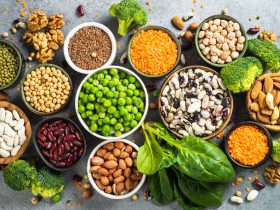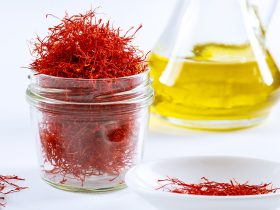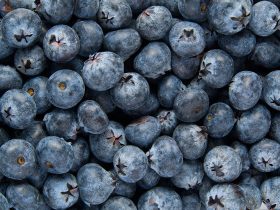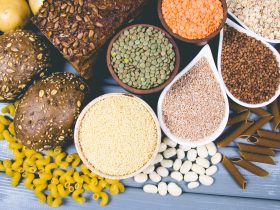Nutritional yeast, also known as savory yeast or nooch, is an inactive type of yeast produced from sugarcane and beet molasses.
The scientific term for this yeast is Saccharomyces cerevisiae, a sugar-eating fungus that utilizes sugar for energy. Nutritional yeast is yellow in color and is available in flakes, granules, or powder form. It is renowned for its savory taste, versatility, and numerous health benefits. Let’s talk about it!
What Is Nutritional Yeast?
Nutritional yeast is a product obtained through a process involving the growth, harvest, and processing of yeast cells, particularly Saccharomyces cerevisiae. The steps in its production include seeding, cultivation, harvesting, fortification (optional), and drying.
Production Process
- Seeding
- A pure parent yeast culture of Saccharomyces cerevisiae is initiated.
- The seed yeast is cultivated in a sterile environment and later transferred to a suitable container for further growth.
- Cultivation
- The yeast is cultivated under controlled conditions, regulating factors like temperature and pH to optimize growth.
- A nutrient-rich and purified medium, along with adequate aeration, supports the yeast’s development.
- Harvesting
- After the cultivation process, the fermented yeast liquid undergoes concentration to yield nutritional yeast cream.
- This cream is then pasteurized, rendering the yeast inactive.
- Fortification (Optional)
- Fortification may occur at this stage, involving the addition of specific micronutrients. Commonly, vitamin B12 is added to enhance the yeast’s nutritional profile.
- Drying
- The yeast cream is dried and processed into various forms, such as flakes, powder, or granules, depending on consumer preferences.
Varieties of Nutritional Yeast
- Unfortified: Contains only the naturally occurring vitamins and minerals in the yeast.
- Fortified: Includes additional micronutrients added during manufacturing. This type is beneficial for those seeking specific nutrient boosts, such as vitamin B12.
Nutritional yeast is celebrated for its nutrient-rich composition, including fiber, protein, B vitamins, zinc, and more.
Known by various names globally, such as “nooch” (nüch), “yeshi” (Ethiopian for “for a thousand”), “savory yeast flakes” (Australia), and “brufax” (New Zealand).
Understanding the production and varieties helps consumers choose between unfortified and fortified nutritional yeast based on their dietary needs and preferences.
Nutritional Yeast vs. Brewer’s Yeast
In the realm of yeast, it’s crucial to distinguish between two often-confused varieties – brewer’s yeast and nutritional yeast. Despite belonging to the same scientific family, Saccharomyces cerevisiae, these two yeast types differ significantly in their origins, taste, and nutritional profiles.
Brewer’s yeast, a byproduct of the beer-making process and utilized in bread production, is characterized by a distinct bitter taste. Its origin lies in the remnants left after brewing beer, making it a secondary product of the brewing industry.
While sharing the same scientific lineage as nutritional yeast, the crucial disparity lies in their nutritional content.
Nutritional Values of Nutritional Yeast
In the realm of dietary supplementation, nutritional yeast emerges as a powerhouse, especially catering to the nutritional needs of vegans and vegetarians who often grapple with obtaining sufficient B vitamins in their diets.
While it cannot replace whole foods, nutritional yeast serves as a valuable ally, offering a concentrated source of essential nutrients.
A two-tablespoon serving (approximately nine grams) of nutritional yeast boasts an impressive nutritional profile:
- Calories: 35
- Total Carbohydrates: 3 g
- Fiber: 2 g
- Total Fat: 0.5 g
- Protein: 5 g
- Vitamin B12: 14 mcg (583% DV)
- Thiamine: 6 mg (500% DV)
- Riboflavin: 6 mg (462% DV)
- Vitamin B6: 6 mg (353% DV)
- Niacin: 32 mg (200% DV)
- Folate: 405 mcg (101% DV)
Daily Value: Percentages are based on a diet of 2,000 calories a day.
In addition to the core nutrients mentioned, nutritional yeast also contributes to the intake of essential minerals, including zinc, pantothenic acid, magnesium, copper, manganese, iron, calcium, and potassium. This comprehensive nutritional package makes it a valuable addition to diets aiming for a diverse range of vitamins and minerals.
It’s important to note that the presented nutrition facts depict a fortified version of nutritional yeast.
However, for those who prefer an unfortified option, it’s readily available in the market. Some individuals may choose to blend both fortified and unfortified varieties to strike a balance and optimize health benefits.
Multifaceted Benefits of Nutritional Yeast
Nutritional yeast, often hailed as a superfood, transcends its culinary use and emerges as a potent source of health benefits.
Delving into its nutritional profile reveals a spectrum of advantages that contribute to overall well-being.
- Antiviral and Antibacterial Properties
Clinical trials highlight the resistance of S. cerevisiae to antibacterial antibiotics, showcasing its potential in supporting patients undergoing antibiotic therapy.
With documented antiviral and immune-modulating properties, nutritional yeast emerges as a promising alternative for combating infections, including Candida.
- Preserves Immune Function
Nutritional yeast stands as a guardian of immune function, providing compounds like beta-1,3 glucan, trehalose, mannan, and glutathione.
Animal studies indicate potential benefits, showcasing how these compounds reduce infection risk and even contribute to the treatment of lymphoma, emphasizing the immune-boosting prowess of nutritional yeast.
- Digestive Health and Lactose Intolerance
Noted for its positive effects on gut health, nutritional yeast aids in the treatment of diarrhea, according to German monographs. The presence of probiotics contributes to these benefits. Additionally, its dairy-free nature makes it a suitable option for those with lactose intolerance.
- Promotes Healthy Hair, Skin, and Nails
Enriched with B vitamins, including biotin and niacin, nutritional yeast becomes an ally for healthy hair, skin, and nails. Biotin supports hair and skin health, while niacin is employed in treating chronic acne and enhancing overall skin health.
- High in Protein
A nutritional powerhouse, nutritional yeast is a complete protein, containing essential amino acids. This attribute is particularly advantageous for vegans and vegetarians seeking diverse protein sources in their diets, ensuring comprehensive nutrition.
- Rich in Vitamin B12
Vitamin B12 content in nutritional yeast addresses a common concern for vegans and vegetarians. Studies suggest that supplementing with fortified nutritional yeast effectively restores B12 levels, vital for DNA synthesis, red blood cell production, and nervous system health.
- Supports Healthy Cholesterol Levels
While research on nutritional yeast’s direct effect on cholesterol is ongoing, its beta-glucan content is recognized for lowering LDL cholesterol. Studies indicate the potential of beta-glucans to reduce non-HDL cholesterol levels without affecting HDL or triglyceride levels.
- Supports Healthy Pregnancy
Abundant in B vitamins like thiamine, riboflavin, vitamin B6, and folate, nutritional yeast plays a pivotal role in supporting cell metabolism, nerve function, and mood regulation. Folate, in particular, aids in reducing the risk of birth defects, ensuring a healthy pregnancy.
- Boosts Energy
Vitamin B12, abundant in nutritional yeast, emerges as a key player in boosting energy levels. Its role in enhancing endurance and focus underscores the contribution of nutritional yeast to overall vitality.
In conclusion, nutritional yeast transcends its culinary use, standing as a health-enhancing marvel.
Whether fortifying the immune system, supporting digestive health, or contributing to vital nutrients, nutritional yeast proves to be a versatile ally in the journey toward holistic well-being.
How to Use Nutritional Yeast: Tips and Ideas
If you’re new to nutritional yeast, here are some tips on where to buy it and creative ways to incorporate it into your meals:
- Where to Buy
- Nutritional yeast is widely available and can be found in major grocery stores and online retailers.
- Popular brands include Bragg, Trader Joe’s, and Red Star, but there are many other varieties to explore.
- Popular Uses
- Flakes or Powder: Available in flakes, granules, or powder, nutritional yeast is a versatile ingredient.
- Cheese Substitute: Beloved by vegans and vegetarians, it adds a cheesy flavor to dishes without the high fat and calories associated with cheese.
- Sprinkling: Sprinkle it on pasta, salads, baked or mashed potatoes, soups, and popcorn for added flavor and nutrition.
- Cheese Sauce: Create a delicious nutritional yeast cheese sauce as a lactose-free alternative.
Risks and Side Effects of Nutritional Yeast
For most people, nutritional yeast is a safe and healthy addition to their diet. Here are some considerations regarding potential risks and side effects:
- Yeast Allergy: If you have an allergy to yeast, it’s advisable to avoid nutritional yeast to prevent allergic reactions like hives, itching, swelling, and stomach pain.
- Active Yeast Sensitivity: Nutritional yeast is typically safe for those with sensitivities to active yeast found in bread. It is pasteurized and deactivated during processing.
- Folic Acid Sensitivity: Individuals with difficulty metabolizing folic acid may want to moderate nutritional yeast intake, especially with fortified varieties. Choosing unfortified options can be an alternative.
- Shelf Life: Nutritional yeast does not need refrigeration but should be stored in a dark, cool, and dry area to maximize shelf life.
- Monitoring: Check for any changes in color, taste, or smell to ensure it’s still good before consumption.
- Intolerance Testing: For those trying nutritional yeast for the first time, it’s advisable to start with a small amount and gradually increase it to assess tolerance.
- Expiration: While nutritional yeast can last around a year or two with proper storage, pay attention to signs of spoilage and discard if necessary.
Always consult with a healthcare professional if you have specific concerns or pre-existing conditions. Nutritional yeast is generally well-tolerated, and when consumed in moderation, it can be a valuable addition to a balanced and varied diet.
















Find Us on Socials